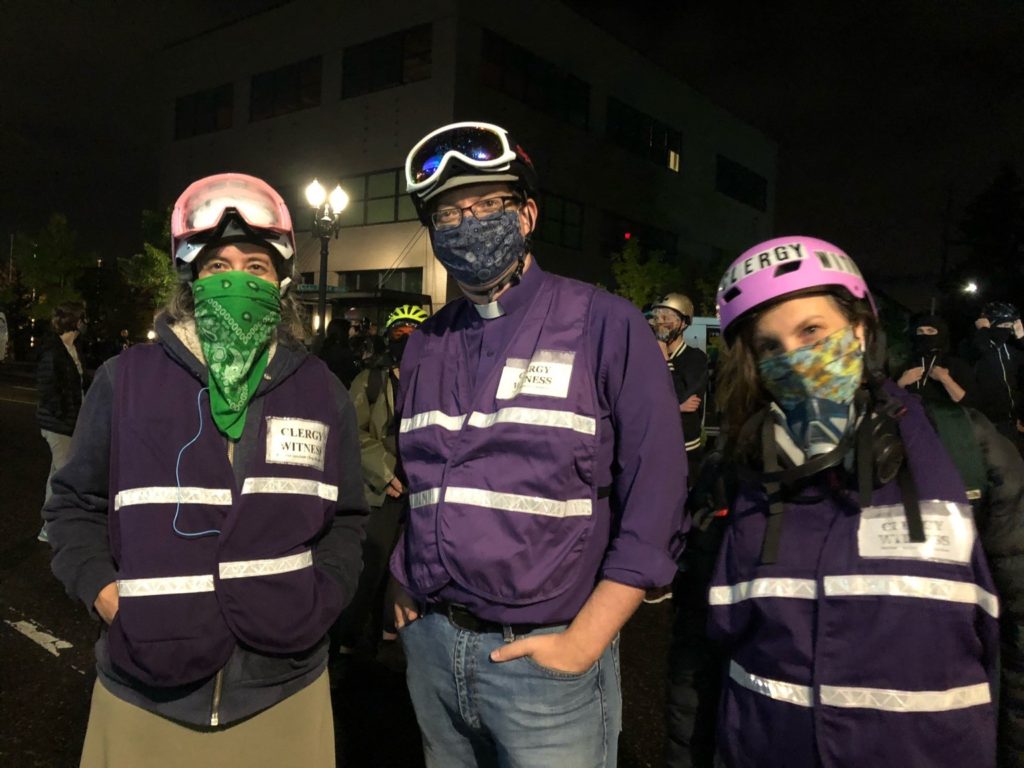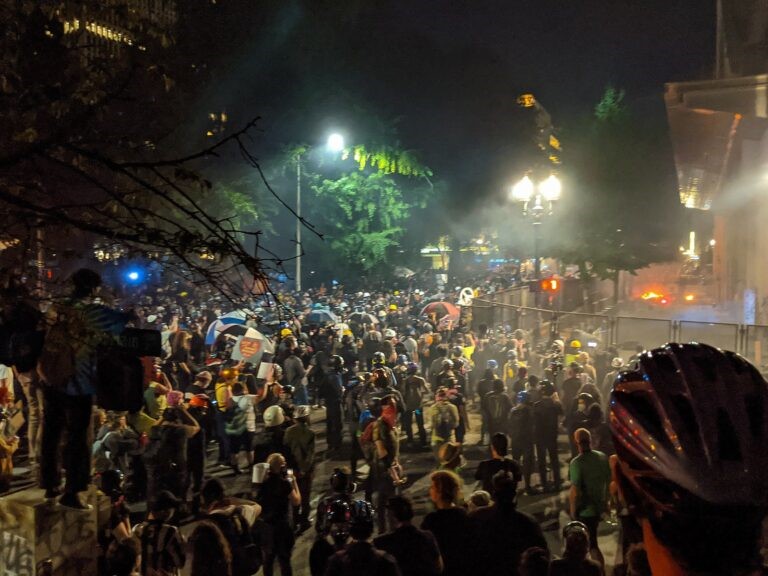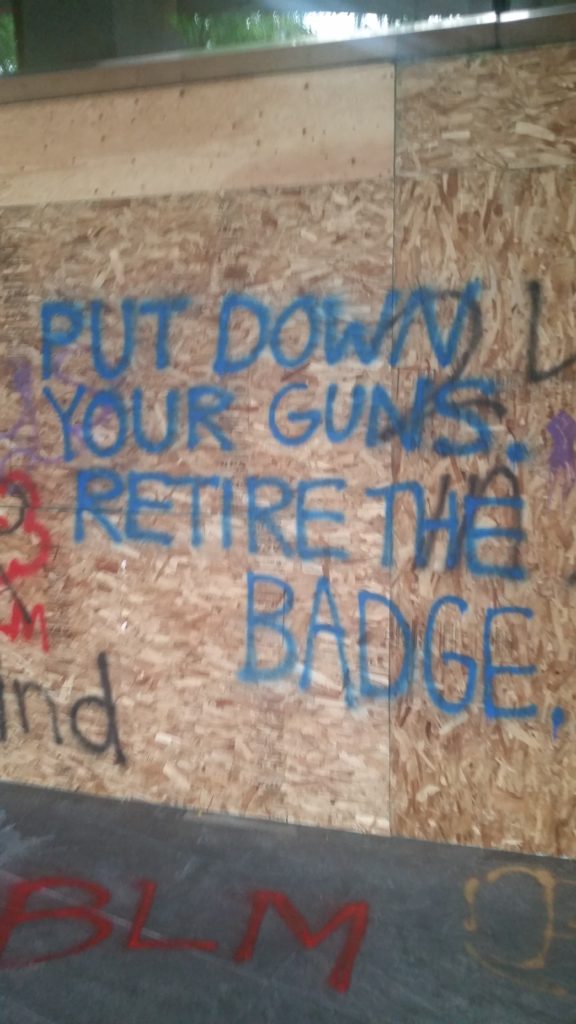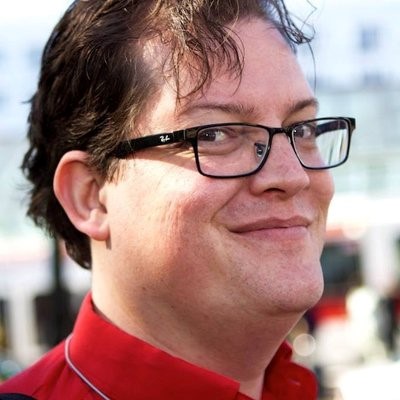A Pastor in the Portland Uprising by Aric Clark
Three days after the last time I was tear-gassed my eyeballs still feel sandy sometimes when I blink. My nostrils still sting slightly, like I cut a jalapeño and carelessly rubbed my nose an hour ago. Gear sits in my laundry room, a bike helmet, ski goggles, masks, a reflective vest, a white tab clergy collar, which I warn my family against handling because I don’t want them getting a small contact dose of whatever noxious plumes of white, green, and orange smoke I was standing in. I’m looking up how best to clean some of this gear before it’s time to don it again and head back into the street for another round.

For now I’m going down a couple times a week or more to the three block stretch of land in the center of Portland, OR that has been the sight of nightly protests against police brutality for the past two months. Compared to some, this is infrequent. There are protesters and journalists who are down there every night. There are houseless members of our community who are living in the park in front of the courthouse 24/7. By their standards I’m practically a tourist. I went down to the protests a few times on my own initiative in the first month, but I’m going regularly now as part of a small cohort of informally organized clergy from many different faith backgrounds. We maintain a nightly presence at the protests. We are led by some truly excellent Rabbis, but we are not leaders in this uprising. We are followers. We are following the lead of Black and Brown organizers in Portland, even if that is not always a straightforward proposition.
Portland isn’t just another iteration of the struggle against racism in America. Portland has its own long-running love-affair with white supremacy. This city is at the end of that famous landmark of settler-colonialism known as the Oregon Trail, with our state lending its name to boost the genocidal project of Manifest Destiny. Our state was founded as a white supremacist utopia constitutionally excluding Blacks and non-Christians from owning land or moving to this region. Oregon was a hotbed of KKK organizing through the early part of the 20th century, with the mayors of Portland openly boasting of their participation. Black neighborhoods in our city have been routinely neglected, allowed to flood, displaced by freeway and infrastructure projects, and heavily overpoliced at every stage of our history. Portland police stop and arrest Black pedestrians and motorists at twice the rate of white ones. And Portland police kill. To the list of Black people murdered by police since the Ferguson uprisings and the Black Lives Matter movement began, Portland adds Andre Gladen, Patrick Kimmons, Terrell Johnson, and Quanice Hayes among others.
Protests in Portland are not new. Under George Bush in the 1990s, frequent protests that included property destruction earned the city the nickname “Little Beirut” (unpack the Islamophobia in that if you have a moment). The current uprising may look like it started with the murder of George Floyd, but huge marches and sustained protests have actually been happening almost continually here since 2014. One of the most important leaders of these actions has been Don’t Shoot PDX, a local Black-led activist and art cooperative. Don’t Shoot PDX is still at the forefront of the present uprising, having recently been given the reigns of two of the most publicized aspects of the protests: the mutual-aid kitchen Riot Ribs, and the Wall of Moms who show up each night in their distinctive yellow shirts.

Even with this history of protest, what is happening in Portland right now is remarkable. When I began writing this, we were on day 62 of nightly resistance and, far from waning, the protests were growing in number and diversifying in tactics. The uprising was also having a moment in the national and even international media, but what the public outside Portland was seeing rarely reflected the actual experience of protesters here on the ground. The media (excluding a handful of local independent journalists who have by and large been doing a heroic job) tended to focus on the federal police intervention and the subsequent surge in activity, but while the unwanted invasion of a heavily-militarized and unaccountable federal police force is indeed a chilling sign of how far our slide into fascism has gotten, the feds didn’t start the violence. Our own Portland Police Bureau was tear gassing and beating and shooting us for weeks before the feds arrived, and they have continued their violent ways after the staged withdrawal of some federal agents. Our mayor Ted Wheeler got his nickname “Tear-Gas Teddy” for how often the police under his authority as police commissioner deployed chemical weapons against his own citizens, not for the one night he engaged in some political theater getting gassed by the feds along with the protesters to register his opposition to the (locally) deeply unpopular Trump regime. If you’ve been watching all this on cable news you’ve likely been fed the idea that we “violent anarchists” deserve what we get from those “federal goons”.
A police officer, who is loosely affiliated with one of the congregations I serve, called me last week to share that he certainly believes protesters deserve what they’re getting, and worse. He had read an email which contained a recording of that week’s sermon in which I shared some examples of the community care I regularly witness at the protests: volunteer medics show up with water bottles to flush eyes, National Lawyers Guild members write their jail support phone number on people’s arms, strangers walk around handing out free vegan burritos and sandwiches and hand-sanitizer and masks. He didn’t appreciate the sympathetic portrayal of the protesters. He let me know that in his opinion we are terrorists and he hopes Trump makes the designation official soon so that they can start to round us up.
Round. Us. Up.
Following that call I retreated to my couch, my hands shaking, my breath unsteady. I laid there and sobbed for maybe half-an-hour afraid to touch my eyes because they were still irritated from the tear gas of a couple nights prior. It isn’t the only time I needed to stop and let the tears flow in the past several weeks, but it was the time I was most annoyed at myself. I’d had flashbangs exploding by my feet and anonymous secret police screaming in my face and threatening me with weapons. I’d witnessed people getting brutally beat, shot with impact munitions, and arrested. Why was I letting a phone call upset me so?
Good friends reminded me of an obvious point: what I’m experiencing is traumatic and I should expect to need to process that trauma. In order to continue to function, I was compartmentalizing what happens on the streets at night away from the rest of my day. But the phone call was a reminder that these things are not separate. It was a reminder that places where I usually feel safe, due to the many privileges afforded me as a straight white cis man, are actually not safe at all for people who don’t share my privileges, and they become increasingly unsafe for me as I become a traitor to my race and class. As a Christian, I have long believed that it is my vocation to try to live so that when oppressive powers accuse me of standing in solidarity with the oppressed, there is sufficient evidence to convict me. These days I’m getting a taste of what that would mean.
Trauma is a good lens to understand what is happening in Portland. Long before I was risking exposure to CS gas, I was accompanying Irene, the mother of Christopher Kalonji, who was murdered by Clackamas County Sheriff’s Deputies during a mental health crisis in 2016 at the age of 19. Christopher was experiencing a paranoid episode due to trauma from previous violent interactions with police while he was home alone. He called 911 seeking medical help, but by the time officers arrived he’d begun to fear they would kill him if he let them in the apartment, so he locked himself into his room. Deputies alleged he had a weapon despite the fact that he had stripped down to his underwear in a panicked attempt to convince them he was unarmed. Nevertheless, they shot him in the chest and in the arm. They proceeded to tear gas the apartment and prevent anyone in the family from entering for over 4 hours till they finally transported him to the hospital where he died. Had he received medical attention sooner he may have lived. Since then, Irene has been planning memorials, protests, and letter-writing campaigns through her organization the Pacific Northwest Family Circle, which she helped found along with other mothers and grandmothers who have lost loved ones to police violence. At her side, I have practiced public grieving and lamentation month after month for years.
For Irene, for Donna Hayes (the grandmother of Quanice Hayes who was murdered by Portland Police in 2017 at the age of 17), and for many others like them, protest isn’t an optional pastime. Their lives have been transformed by trauma such that protest is a necessity as essential as breathing. This is the same feeling I hear expressed at night in front of the Justice Center in downtown Portland by young Black and Brown activists who scream into the megaphone until they’re hoarse that Black Lives Matter. It is the entire animating purpose of the protests which, contrary to media reports, haven’t drifted off message. The nightly chants still revolve around the litany of names: George Floyd, Breonna Taylor, Ahmaud Arbery, and far too many others. The demands of the protestors have been utterly consistent. When Mayor Ted Wheeler made his visit, they were projected three stories high on the courthouse:
- Defund the police by at least 50% and reinvest into communities, especially the Black community
- Free all protesters from jail
- Feds out of Portland now
- Ted Wheeler needs to resign

The protesters are in the streets because of the trauma of 400 years of anti-Black oppression, but also because of the intimate and individual traumas they are suffering in the process of protesting. Watch a protester show up on their first night and stand about nervously staying quiet through chants like “No Justice, No Peace. Take it to the streets and fuck the police!” or “A-C-A-B: All cops are bastards.” Watch that same protester endure their first experience of tear gas and the second night they are back with a better mask and chanting louder than anyone else. In a real sense, each new night of protesting becomes a protest against all the brutality of the previous evenings.
This isn’t just about protest tactics, it’s also an embodied phenomenon. Tear gas hurts. It’s difficult to describe the panic I felt that first time when my eyes were on fire and I couldn’t see, not only because of the gas, but also because it was night and the police were using blindingly bright flood lights, so my vision became an unintelligible swirl of light spots and darkness and tears and smoke, and I could hear people around me running and officers were moving swiftly toward me screaming orders filled with obscenities and threatening me with further violence – violence I’d seen them enact on others. It would have been easy for that panic to become paralyzing, but then there was someone next to me offering to help wash out my eyes. Maybe they were a field medic. Maybe they were just some random protester with more experience than I had, but they got my face tilted back and started pouring water over my rapidly blinking eyes and before I could see again they were already gone helping someone else. Around me I noticed others shaking water off their faces and trying to resist rubbing their eyes. Some of the protesters had held their ground, either because they had better masks than me, or because they are just made of stronger stuff, but the rest of the crowd was starting to return and someone had a loud stereo playing dance music. A party was starting right there in the street in front of the courthouse minutes after a CS gas attack. Fireworks exploded in the smoke. It looked for all the world like a nightclub, and I felt the adrenaline starting to work its way out of my body, fear giving way to a weird kind of joy.
I’ve been cautious and fortunate. I’ve only been hit by tear gas a couple times and the eye pain and the coughing are the worst symptoms I’ve experienced. Protesters who are down there every night or who stand on the front line often suffer much worse. The gas is messing with people’s respiratory and reproductive systems. It irritates the skin and burns all of your soft tissue. It lingers in the air and settles on surfaces. Protesters often describe the air near the Justice Center as “spicy” hours after the last attack. Residents of downtown apartments are suing the city claiming they are suffering the effects of tear gas in their own homes. Employees in the courthouse are noticing tear gas on surfaces like light switches on the 7th floor of that building. Lately new types of gas seem to be being deployed which cause intense vomiting episodes and shakes. It’s worth remembering that there are no scientific studies to tell us the long-term effects of deploying tear gas in these quantities and using tear gas in war is against the Geneva Conventions. Hence our mayor’s other nickname: “War Crimes Wheeler.”
Protests in Portland always come with a hefty dose of the absurd. On one occasion I saw an entire brass band dressed in banana costumes. These recent nightly resistance actions often have bubble machines and confetti cannons. There was a llama in the crowd this last Saturday as well as a Santa Claus. I’m no less absurd I suppose, in a city famed for being irreligious, standing in my stole and my clergy collar and a bike helmet I self-consciously matched to my vestments with a sign offering protesters blessings. “Remember that you are sacred, and Black lives are sacred,” I tell them, “Remember that you are beloved and remember that the public face of love is justice.” Even those who accept my offer of a blessing usually look more confused than grateful. Trust of clergy is not high down here. Too many representatives of religion have used the authority of their office to chide the protesters for failing standards of politeness or nonviolence that they never agreed to. Too many of us clergy have shown up to lead candlelight vigils while the cameras are watching, but then gone home to our beds before the police start their riot.
The dancing, the absurdity, the profanity, even the graffiti: these are all tools for transforming the trauma into a powerful resolve. These are the fertile soil in which courage can flourish, and courage is the first of human virtues, because it makes all the other virtues possible.
There is no serious moral argument to be made that nightly irreverence or property destruction by the protesters is an adequate justification for the overwhelming violence of the state. First, it is comically disproportionate. We are meant to believe that some rude chants, some hurled water bottles, the odd firework, and some viciously aimed laser pointers are terrifying life-threatening dangers to these militarized pretend soldiers in body armor with assault rifles. Simultaneously we are expected to swallow the idea that $20,000 worth of tear gas used in a single night, along with countless impact munitions that have put multiple people into the hospital with grievous head wounds, and dozens of filmed instances of officers beating civilians with steel batons, is all just ordinary—even RESTRAINED—use of force by a reluctant peace-loving police department. Even my credulity can’t take the strain and I believe in a Jewish guy who came back from the dead.
Second, it is past time we stopped tolerating the repugnant idea that property rights are more important than human rights. One of the key arguments for defunding the police is that they are essentially bureaucrats with batons (h/t David Graeber). They bring force into situations that do not require it. The majority of policing isn’t about preventing violent crime, but the much less sexy job of code enforcement: it has to do with protecting the rights of property owners. Over half of all arrests made by Portland Police in 2017 were people experiencing houselessness. A major reason policing in the USA has such predictably racist outcomes, no matter who is wearing the uniform, is that our law and culture fundamentally teaches that white people get to own property, while Black people ARE property. Some of the first police agencies were slave catching patrols. It is therefore on-brand to see police used to defend an empty courthouse and racist statues at serious risk to human lives. Even though it is more American than apple pie, it is infuriating in the extreme to listen to people moralize about graffiti and broken windows while ignoring the broken skulls of protesters and the dead bodies of black men and women, whose lives are the reason for the uprising.
The narrative that there are good protesters and bad protesters is a red herring designed to distract us from how utterly messed up our social systems are. I’m committed to nonviolence for reasons based on my faith, and based on my theory of change, but I can tell the difference between people fighting for our collective liberty with tactics I wouldn’t personally choose, and people deploying respectability politics and law and order rhetoric to make it easier for the police brutality to continue. I no longer have time for the latter group. The Portland Police are still bull-rushing protesters, beating them with batons, deploying gas, and firing “less-lethal” munitions of various kinds every night. I’ve got to find a better gas mask before my next shift in the streets begins.
The Rev. Aric Clark is a pastor, father, writer and activist living in Portland Oregon. When he isn’t protesting, he’s probably playing a board game.

